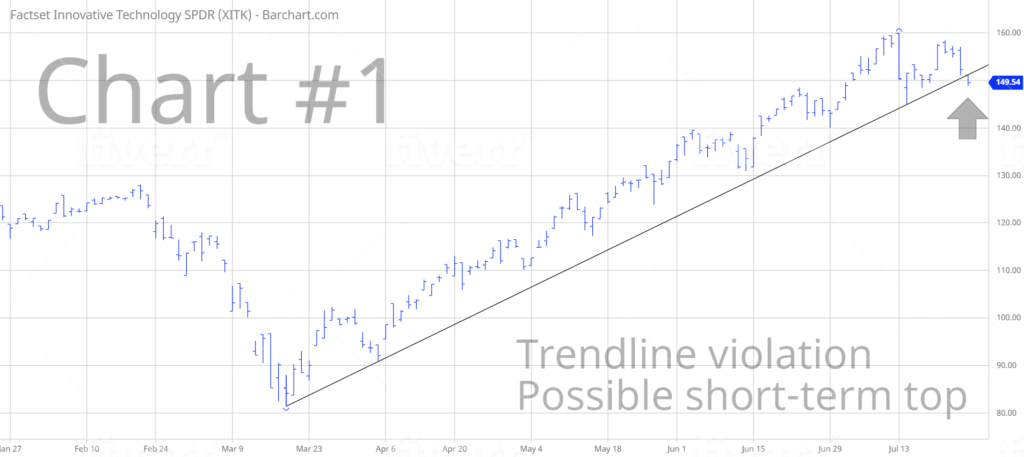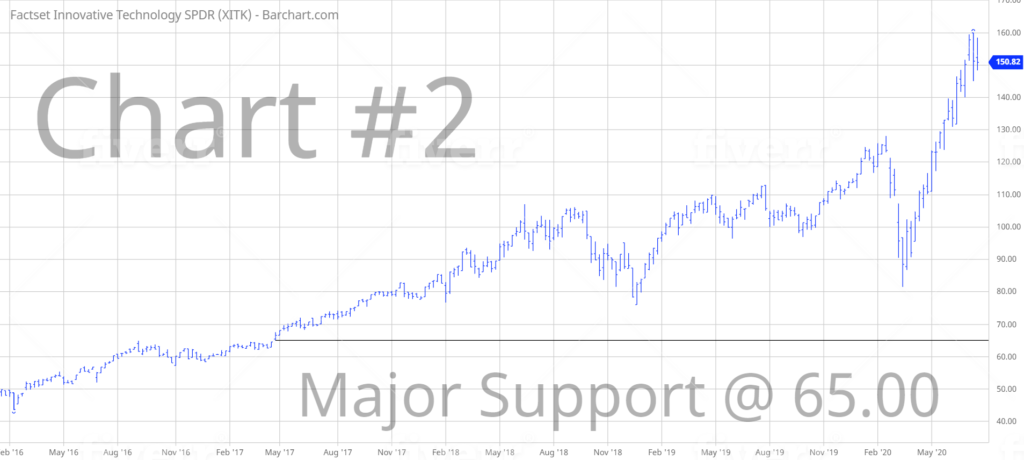
SPDR FactSet Innovative Technology ETF (XITK)
Key Statistics
Minor Support Level 123.27 Minor Resistance Level 153.33
Major Support Level 64.59 Major Resistance Level 166.54
Minor Buy Signal 159.90 Minor Sell Signal 117.26
Major Buy Signal 177.28 Major Sell Signal 52.00
BRIEF OVERVIEW – XITK
What is America 2.0? It is a term used to describe a new economic and manufacturing boom that is being driven by a variety of next-generation technological innovations, industrial upgrades and consumer trends. America 2.0 has the potential to completely remake the world we live in by creating a new-world economy that will replace old-world industries, manufacturers and traditional businesses. Most likely, fifty years from now, historians will describe this time period as the Fourth Industrial Revolution. Before we continue with our analysis of America 2.0, let’s briefly review the industrial revolutions of previous generations. This will give us a general idea of what we can expect from today’s economic revolution.
The Industrial Revolution (1760 – 1840)
Arguably, the Industrial Revolution was the most important turning point in the history of the global economy. It involved the transition to new manufacturing processes. More specifically, the Industrial Revolution was responsible for transiting from hand production methods to machines. It also included new types of chemical manufacturing, iron production processes, the development of machine tools and the beginning of the factory system.
The Industrial Revolution impacted almost every aspect of our daily lives. The most significant impact was a dramatic increase in workers’ income. As a result, families enjoyed a boost in their standard of living. For the first time in recorded history, the general population experienced a steady increase in their standard of living. In turn, this allowed consumers to increase their purchases of goods and services, which provided a huge boost to the overall economy.
The Industrial Revolution also marked the beginning of a structural change from an agrarian economy to an industrial economy. Prior to the Industrial Revolution, the economy in North America was an agriculture based economy. In fact, 90% of the population lived on farms. Today, less than 1% of the North American population resides on a farm. The Industrial Revolution marked “the beginning of the end” for the agriculture based economy.
Technological Revolution (1870 – 1914)
The Technological Revolution (also known as the Second Industrial Revolution) was characterized by a rapid period of industrialization from the late-19th century to the early-20th century. The most notable development during this period of time was the building of the railroad network, primarily throughout Britain, Germany and the United States. Equally important was the expansion of telegraph lines along with the invention of the telephone and electrical power.
The railroad network and telegraph expansion allowed for an unprecedented movement of goods and services as well as human capital. This created a wave of globalization which dramatically increased economic activity across North America and other countries with a rail service. In order to meet the growing demand for goods and services, manufacturing companies began using the assembly line as a way to increase output.
Unquestionably, the business owner who enjoyed the greatest success with the assembly line was Henry Ford, who started the Ford Motor Company in June 1903. Prior to Ford’s use of the assembly line in automobile manufacturing, it was very expensive to produce an affordable vehicle for the average American consumer. The amount of labor required to manufacture an automobile made it impossible to lower the cost. Ford revolutionized the auto industry when he began manufacturing his vehicles using the assembly line. Workers were strategically placed throughout Ford’s manufacturing facility. Each worker performed a specific task as the vehicle made its way along a conveyor belt. This method was incredibly successful in reducing the manufacturing costs.
In October 1908, Ford introduced the Model T with a sticker price of $825. Immediately, sales began to skyrocket. For the first time in automotive history, the average American could afford to own an automobile. Thanks to Ford’s assembly line as well as his constant effort to increase efficiency, the price of the Model T declined every year for the next several years. By 1916, the price had dropped to $360. By 1918, half of all cars in America were Model Ts. Thanks to Henry Ford and his use of the assembly line, the automobile eventually became a standard item for most Americans (as opposed to a luxury item).
Digital Revolution (1977 – 2010)
The Digital Revolution (also known as the Third Industrial Revolution) officially began in 1977, with the introduction of home computers by Apple and Commodore. Essentially, the Digital Revolution represents the shift from mechanical technology to digital electronics. It is highlighted by the adoption and proliferation of digital computers and digital recordkeeping that continues to the present day.
The Digital Revolution has been filled with a number of new technological breakthroughs. The majority of these discoveries are in the area of personal entertainment. The list includes arcade video games, automated teller machines (ATM machine), electronic music, CD-ROM, digital camera, World Wide Web, HDTV, cell phones, text messaging and many other important discoveries.
In addition to major discoveries, some of the most important companies were founded during the Digital Revolution. A few examples include Microsoft, Apple, Google, Facebook, Amazon, Uber, Airbnb and Netflix. Some of the brightest entrepreneurs in the history of technology have played an important role in shaping the Digital Revolution. The list includes Bill Gates, Steve Jobs, Jeff Bezos and Reed Hastings.
Arguably, the two most important discoveries during this time period are the World Wide Web and the cell phone. These two discoveries have dramatically improved the way consumers communicate, work, travel, shop, eat and educate themselves. Even though the internet and the cell phone have been in existence for over 30 years, these items still influence our lives on a daily basis. They have become imbedded in our social fabric.
Information Age Introduces The Fourth Industrial Revolution
The Digital Revolution was part of a much larger time period known as the Information Age, which was characterized by a rapid shift from traditional industries to an economy based on information technology. The Information Age actually predates the Digital Revolution. It began in 1954 with the introduction of the mainframe computer, which is used primarily by large corporations for bulk data processing. The next important discovery during the Information Age was the microchip in 1968, which was followed by the personal computer in 1982. In 1996, the Information Age ushered in the arrival of the internet. The MobileNet became popular in 2010. This refers to the digitization of commerce, buying goods and services electronically instead of visiting a brick and mortar store.
In all likelihood, historians will use the Information Age to bridge the gap between the Third Industrial Revolution and Fourth Industrial Revolution. Arguably, America 2.0 has the potential to become the greatest tech revolution in modern history.
In an effort to allow investors to participate in the Fourth Industrial Revolution, the SPDR family of exchange traded funds (distributed by State Street Global Advisors) introduced the FactSet Innovative Technology ETF on 13 January 2016. The ticker symbol is XITK. The objective of the fund is to invest in technology-related companies that provide leading-edge products and services, particularly in the sub-sector of electronic media. The top five holdings include Zoom Video Communications, Sea Ltd, Bilibili Inc, Shopify Inc and Zscaler Inc.
SHORT-TERM VIEW – XITK
The short-term momentum is heavily in favor of the bulls. XITK has enjoyed a dramatic rally following the coronavirus sell-off in Q1 2020. The ETF has increased 87% since March 18. This is a perfect indication that investors are fully onboard with America 2.0. In order to reverse the momentum, the bears need a weekly close below 123.27.
LONG-TERM VIEW – XITK
As a general rule, people don’t like change. Instead, they prefer the familiarity of a predictable routine. Unfortunately, many people will not enjoy America 2.0 because it will definitely disrupt their familiar way of life. However, whether we like it or not, the Fourth Industrial Revolution is upon us and it will continue to move forward for the next several years.
What are a few examples of America 2.0? It includes such things as internet-based businesses replacing brick-and-mortar businesses, 3D printers replacing old-world factory machines, autonomous vehicles sharing the road with gasoline-fueled cars, robots replacing human workers, artificial intelligence, renewable energy and financial technology. These are just a few examples of how the Fourth Industrial Revolution is advancing the global economy into a new frontier.
Without question, the driving force behind America 2.0 is the millennial generation. With a demographic population of 92 million, millennials represent the biggest generation in the history of the United States. What makes this generation so important compared to previous generations? There are three main reasons why millennials will be influential in shaping the next 20 to 30 years.
Three main characteristics of millennials
- The sheer size of the millennial generation will be used to shape America 2.0
- Millennials are the most tech savvy generation in US history
- Millennials have very little brand loyalty, thereby forcing businesses to innovate
Going forward, it will not be a good idea to bet against the millennial generation. Based on the fact that this generation contains 92 million consumers, they will play a huge role in determining the social, political and economic direction of the next few decades. Given their technology background, millennials will not be nearly as apprehensive about moving forward into this new technology-based landscape. As a general rule, the millennial generation does not place much emphasis on brand loyalty. Therefore, businesses will be constantly upgrading and improving their goods and services in an effort to capture millennial market share.
Who will be the big winners in America 2.0? Industries that are involved in new technological innovations. The list includes: manufacturing, retail, health care, entertainment, housing and media. Companies with the ability to catch the mega trends within these specific industries will capture the lion’s share of the profit potential.
There is no doubt that COVID-19 has dramatically pushed forward the America 2.0 narrative. Prior to the virus, absolutely nobody in the mainstream media was talking about America 2.0. Today, everybody is discussing this new trend. In fact, a few presidential candidates were even mentioning this new paradigm in campaign speeches.
Many pundits in the financial media claim that America 2.0 is simply an overused buzz word with little empirical evidence of actual transformation into a new technology-laden economy.
Nothing could be further from the truth. Changes are occurring everywhere. A perfect example is the recent shift to a remote workforce. This new mega trend will unleash tremendous disruption across several industry groups. Another example of America 2.0 is the proliferation of talented young workers leaving their “old school” financial services jobs on Wall Street in favor of decentralized finance. Several of the “old guard” industries like oil & gas, entertainment, transportation and lodging are having a very time raising capital as they adjust to their new role in America 2.0. There is simply no investor demand to participate in a debt issuance or a new stock offering from any of these old industries. Instead, investors are pivoting into technology-driven companies. The momentum in some of these tech-heavy companies is off the chart.
Typically, these massive economic transformations will last 40 to 60 years. In fact, the First Industrial Revolution lasted approximately 80 years. However, advances in technology will probably compress the Fourth Industrial Revolution into a smaller time period. Most historians agree that the Fourth Industrial Revolution began in 2010. Therefore, we can expect this new wave of technological innovation to continue until at least 2030. Probably 2040.
In regard to XITK, the ETF has only been in existence since January 2016. Therefore, it’s difficult to examine the long-term trend. XITK has performed incredibly well dating back to its launch date on 13 January 2016. The ETF did experience a violent decline during the initial shock of the coronavirus in February and March. However, XITK has enjoyed a substantial rally during the past few months. Since 18 March, XITK has increased 85%. Most likely, this trend will continue as the domestic economy finds itself in the middle of the Fourth Industrial Revolution.
SHORT-TERM CHART – XITK
Please review the 6-month chart of XITK (Chart #1). The ETF has generated a sharp rally during the past few months. However, it does appear that XITK formed a short-term top @ 159.90 based on the trendline violation. The chart pattern turns bearish on a weekly close below 123.27.
LONG-TERM CHART – XITK
Please review the 4-year chart of XITK (Chart #2). This chart covers the entire trading history of XITK. Based on its limited trading history, a long-term analysis is not possible. However, XITK has performed quite well since its trading inception in January 2016. The next important resistance level is 166.54.



